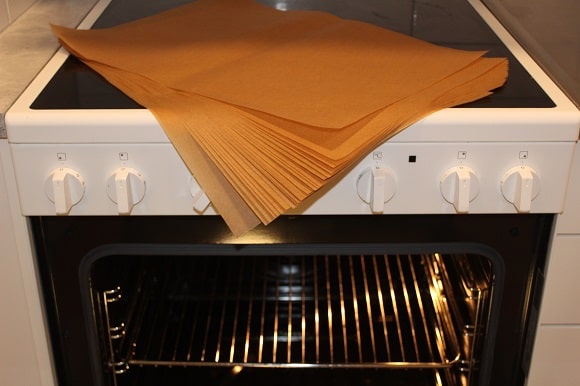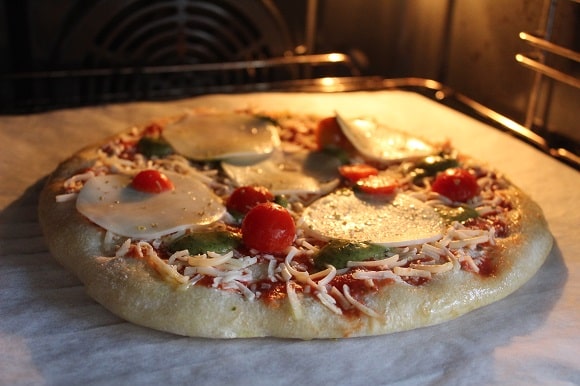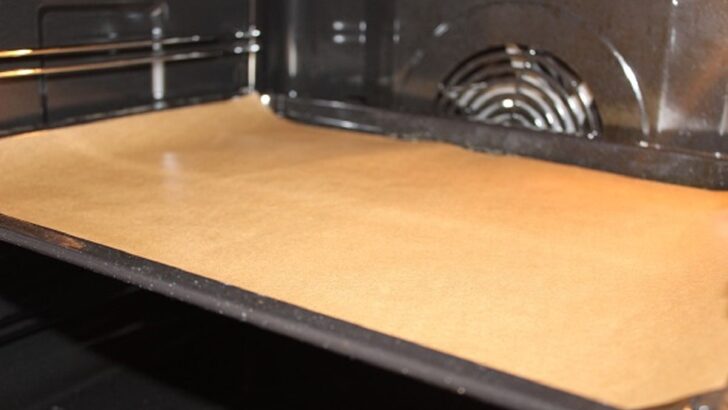Parchment paper is endlessly helpful when it comes to baking. It can be the difference between perfect cookies and gross burnt bottoms.
You can bake a thousand things with parchment paper at various oven temperatures; it’s that versatile.
But how can a paper product be that resistant to heat? And can parchment paper actually burn in your oven?
The average kitchen-use parchment paper has a highly durable and heat-resistant surface and is made to withstand temperatures between 400°F and 450°F. However, higher temperatures or direct contact with heat sources can cause it to burn.
Read on to find out all the details about this great baking aid, and learn how to safely use parchment paper in your kitchen with this helpful guide!
At What Temperature Does Parchment Paper Burn?

On average, parchment paper is rated for oven temperatures up to 400°F to 450°F.
Some will start to brown or break down at around 400°F, while others will remain intact at temperatures of about 450°F.
I’ve even read a few stories by pizza bakers who claim that their parchment paper does fine in temperatures of up to 500°F.
I guess this greatly varies and depends on many factors, including the paper’s brand, the oven type, and the food being prepared.
And while you might notice your parchment paper to brown or break down, it will commonly not burn in a conventional oven environment. Even at those maximum temperatures!
Parchment paper is more sturdy than one might think. After all, it’s just paper, right?
Well, yes and no! The parchment paper’s surface is both non-stick, heat-, and grease-resistant. It also has excellent humidity resistance, making it the perfect baking paper.
It has all these fantastic features thanks to a thin coating of silicone, which has a long list of great properties that come in handy for baking and cooking foods.
Furthermore, most parchment paper brands are biodegradable, and you can even reuse them for a second round of baking without losing their protective silicone coating. It truly is a powerful and marvelous modern baking aid!
However, if the temperature of your oven gets too high, or your parchment paper gets into direct contact with the heat source of your oven (or an open flame), it can actually start to burn!
Thanks to its silicone coating, it’s unlikely that the fire will spread fast and uncontrollably, but, unlike some people claim, parchment paper can catch on fire!
How Do You Keep Parchment Paper from Burning?
Luckily, parchment paper is already made to help avoid burning, so home chefs usually don’t have to make many extra considerations to use this tool safely.
Nevertheless, safety in your kitchen should always be a priority!
These easy steps can help keep your kitchen safe and clean:
Don’t Play with Fire
It may sound like common sense, but keep parchment paper away from open flames. It can be easy to lose track of little things in a busy kitchen, but keeping all paper and cloth items away from open fire or any heat sources is a safety must!
Know the Rating
Check the heat rating; this is usually located on the back of the box. Avoid heating the paper above its suggested highest temperature if you don’t know that it can handle it!
Reuse Wisely
Only reuse parchment paper for baking once, no more! If it’s already been exposed to heat twice, there is a risk that the paper and its coating are brittle, making it more likely to fume or start burning.
Stay Dry
Parchment paper is water-resistant but not waterproof. Prolonged exposure to water will cause its protective coating to break down, making it unsafe for future use.
RELATED READING: Can You Resuse Parchment Paper?
What to Do If Your Parchment Paper Catches Fire?

Kitchen accidents can happen, so try to be prepared. If parchment accidentally gets too close to a burner or an open flame and lights on fire, chances are that it will either go out on its own (thanks to its silicone coating) or start to burn very slowly.
But regardless of that, always have a fire extinguisher close by and use a kitchen fan to help with any smoke.
Also, do not panic! If possible, move the burning paper to your kitchen sink and put out the fire under running water. That will do the trick most of the time!
Should the parchment paper start to burn in the oven, you can quickly put it out with the fire extinguisher or by pouring baking soda over the flame. And remember to turn off your oven as soon as possible!
If all else fails and the fire somehow spreads, leave the kitchen and your apartment or house (if necessary) and call 911! Better to be safe than sorry, right?
Is Parchment Paper Toxic When Burned?
Parchment paper is made for kitchen use. That means that the manufacturers have taken extra steps to ensure that this paper is certified food safe!
The paper’s silicone coating will prevent any chemicals from leaching into your food, and if you want to take it one step further, stick to buying brown parchment paper, as this version is non-bleached.
And so, parchment paper is not toxic when heated or burnt. It won’t even release any toxic fumes should it start smoking or catch on fire!
Can You Put Parchment Paper Directly on the Oven Rack?

First and foremost, parchment paper is used to line baking sheets, cake pans, and casserole dishes, but for some foods that don’t have to be baked for very long, you can even put it directly on an oven rack.
Examples here typically include frozen foods such as garlic bread, pizza, or buns.
Those types of food are typically done baking after 10 to 15 minutes, so baking them on parchment paper that you’ve put directly onto your oven rack is generally fine.
Additionally, foods like that are usually not all that fatty or oily, so you won’t have to deal with burnt grease stains in the oven when the bake’s done!
Very cheesy or oily frozen pizzas (with toppings like pesto or different types of cheese) are the obvious exception.
However, for longer cooking times in the oven, you should avoid using parchment directly on your oven racks.
For one thing, the parchment paper’s special protective coating is on the top side. Many ovens use heat from below, so placing the paper directly on the oven’s rack for an extended time would mean exposing its more fragile underside to direct heating.
For another, exposing the parchment to high temperatures over several hours will make it brown and brittle. It could even start to break and smoke, which you’ll want to avoid when baking.
Parchment paper on the oven rack is totally okay for shorter cooking times up to 15 minutes. For longer cooking times, stick to lining sheets, pans, and dishes only!
Is Parchment Paper Safer Than Aluminum Foil?
Some people think that parchment paper and aluminum foil are interchangeable, but that is not true. Parchment paper is generally the safer choice when aiming to line pans for roasting or baking in the oven.
Parchment paper is a more fail-safe option regarding food release.
Some foods can get stuck to foil, which can cause tiny pieces of it to get attached to your beautifully cooked food.
Additionally, aluminum foil contains metals such as lead, cadmium, chromium, and arsenic.
Trace amounts of these metals can leach into foods when aluminum foil is heated in the oven, and studies have shown that the concentrations can potentially be high enough to cause health risks to consumers.
That’s one reason my husband Max and I have stopped using aluminum foil for baking and barbequing meats altogether.
Is Parchment Paper Safer Than Wax Paper?
Thanks to its silicone coating and heat resistance, parchment paper is the safest choice for baking and roasting at high oven temperatures.
Both parchment and wax paper are labeled food-safe and non-stick, but that is about the extent of their similarities.
Wax paper is not recommended for baking in the oven, as its wax coating can cause it to both melt, smoke, and burn at high temperatures.
So please remember; NEVER use wax paper in the oven!
On the contrary, wax paper is an excellent choice for wrapping foods and storing them in the refrigerator.
Many wax paper brands can also withstand microwave temperatures, making this type of paper a far better and safer choice than plastic wrap, which can melt at too high temperatures, or aluminum foil, which is labeled non-safe for use in microwave ovens.
Related Articles
Recent Posts
Frozen pizza dough is generally pre-cooked, which means it is recommended and completely safe to put it directly on the oven rack for baking. The dough won't fall through the metal bars, and the...
Can You Deep Fry Frozen French Fries? (Important Food Facts)
You can and should deep fry your french fries while they are still frozen. This will reduce cooking time and enhance your fries' quality, as deep frying them will make them deliciously crispy on the...

